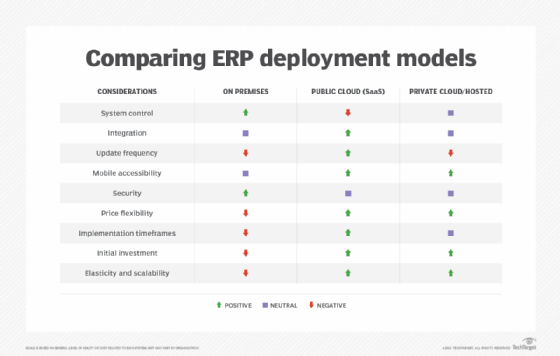
SaaS ERP
What is SaaS ERP?
SaaS ERP is a type of cloud-based enterprise resource planning software that runs on the vendor or cloud provider's servers, is sold through subscription and delivered as a service over the internet.
Software as a service (SaaS) ERP usually employs a multi-tenant SaaS architecture, in which multiple purchasers share the same instance, or copy, of the software, underlying infrastructure and database, but with each tenant's data securely separated. The vendor controls when the software is updated, usually quarterly, and all users get updates at the same time. Features of the software are standardized for everyone and cannot typically be customized easily.
SaaS ERP may also be offered in single-tenant mode where each customer gets its own instance of the software and database and typically has some control over updates and customization. Companies often choose single-tenant SaaS ERP to suit their privacy policy or to meet government regulations on data privacy and security.
Differences between SaaS ERP, Cloud ERP and on-premises ERP
ERP is a modular software system intended to integrate the business processes of an organization, such as accounting, human capital management and procurement, with a central database for storing and sharing information between modules. Regardless of whether it runs on premises on the owner's networked computers or externally on remote servers in the cloud, ERP digitizes and standardizes business records and transactions, improves communication across departments, speeds up business processes, more closely integrates customers, suppliers and partners and improves data accuracy.
SaaS ERP is a subset of cloud ERP, and the terms are often conflated. The term cloud ERP is much more commonly used, and vendors who only sell SaaS ERP often market it as cloud ERP. However, not all cloud ERP is SaaS, and other kinds of cloud ERP differ in important ways, primarily in lacking multi-tenancy and regular updates initiated by the vendor.
Cloud ERP also includes private cloud, typically a single instance of the on-premises software that runs on the ERP vendor's cloud or that of a public cloud service provider such as AWS or Microsoft Azure. The ERP owner decides when to upgrade the software and has some control and responsibility over the infrastructure. It's also possible for an ERP owner to run its private cloud internally on its own cloud infrastructure.
Hosted ERP is another common name for remotely accessed on-premises ERP that runs on an outside provider's data centers. While some vendors market it as cloud, hosted ERP usually lacks the low cost, resource sharing and ease of deployment that distinguish multi-tenant SaaS. It does, however, have many of the benefits of on-premises ERP, such as customizability and control over the timing of upgrades. It also provides some key advantages of cloud infrastructure, including subscription pricing and the ability to adjust computing resources to meet changing needs.

The program code of SaaS ERP products is another differentiator. ERP vendors who offer both on-premises and SaaS ERP typically use the code from their on-premises ERP software as the basis for the cloud product. The code for SaaS ERP, however, is usually a smaller, more streamlined, mostly new version with fewer features.
In practice, cloud service providers and ERP vendors blend some of the features of single tenancy and multi-tenancy at different layers of the cloud "stack." For example, a cloud service provider might offer a multi-tenant version of infrastructure as a service, the servers, storage, networking hardware and related software that comprise a data center. The SaaS ERP system itself, however, might be single tenant. The result, in theory, is ERP that combines the cloud's biggest advantages -- the efficiency, economies and flexibility, or "elasticity" in cloud parlance, of shared multi-tenant services -- with the privacy and control of a single-tenant application. Some SaaS ERP providers offer an additional layer of multi-tenant infrastructure that allows the programming of custom extensions to the single code base, as well as prepackaged specialized applications, effectively providing a degree of customization of their SaaS ERP.
According to market researchers and ERP vendor financial statements, on-premises, hosted and private cloud ERP together far outsell SaaS ERP, but the latter is growing at double-digit annual rates. Starting in the late 2010s, SaaS became the preferred deployment mechanism for the human resources component of ERP. Customer relationship management is another ERP function now commonly delivered as SaaS.
The complexity of cloud options can make it challenging for prospective purchasers to distinguish SaaS ERP from other cloud ERP. According to Forrester Research, the strict definition of SaaS requires all of the following elements to be present:
- Subscription pricing.
- Hosting and management by the ERP vendor.
- Multi-tenancy.
Capabilities and use cases
When it is delivered as SaaS, ERP usually becomes easier to use, less expensive to own and maintain, and more easily connected to other systems and users than on-premises ERP, thanks to the internet's cheap connectivity. SaaS ERP is also the vehicle to which many companies turn to gain access to emerging technologies, such as artificial intelligence, advanced analytics, blockchain and IoT, that require cloud computing's superior processing, data storage and networking capabilities. It is easier for ERP vendors to deliver these new technologies to many users from a single instance of multi-tenant SaaS than from individual customized on-premises ERP systems that are upgraded infrequently.
SaaS ERP use cases are numerous. It is often the first ERP system of small and growing companies because of its low upfront cost and short deployment time. SaaS ERP is also a popular choice for the second ERP platform in two-tier ERP, in which an older on-premises ERP system in corporate headquarters is supplemented with a smaller, more nimble ERP platform in remote offices and overseas divisions. Some companies migrate from an old on-premises ERP system to SaaS ERP because it's the easiest way to get technologies they deem to be strategic priorities, such as AI, big data analytics or omnichannel e-commerce.
Benefits
Many of the benefits of SaaS ERP -- especially compared to on-premises ERP -- are inherent in cloud infrastructure, available in other cloud applications and not unique to ERP. They include the following:
- Fast implementation.
- Economies of scale from resource pooling.
- On-demand self-service "provisioning" of resources.
- Elasticity.
- Easy network access from most devices.
SaaS ERP, however, usually has unique advantages over other types of ERP, including the following:
- More modern user interface.
- Standardized and simplified business processes.
- Emerging technologies that require cloud.
- Fast, frequent updates.
Cost
Because SaaS employs a subscription model, the initial costs to deploy SaaS ERP are a fraction of on-premises ERP, which usually requires an upfront license that can range from several hundred thousand to several million dollars. However, SaaS can begin to exceed the total cost of on-premises ERP after a few years, especially if the number of users grows rapidly. ERP vendors regard SaaS as a more reliable and profitable source of revenue in the long run, in part because it is cheaper for them to service and upgrade than on-premises ERP.
Buyers of SaaS ERP therefore need to scrutinize SaaS subscription models carefully to estimate the total cost of ownership. Subscription options vary widely, from pricing per user to tiered pricing that packages SaaS ERP and cloud services and resources according to company size, among other options. In addition, cloud infrastructure can be subject to separate usage-based pricing that fluctuates according to need.
Implementation
SaaS ERP can be deployed in hours or days because the ERP vendor or cloud partner manages the IT infrastructure and users access the software from a desktop web browser or smartphone app.
However, a SaaS ERP implementation can be slowed by the need to migrate data from the old ERP system. Users also need time to get used to new ways of executing business processes and interacting with the software. Integration can be a hassle because SaaS ERP usually must communicate with other SaaS applications or with on-premises software for functions such as manufacturing and warehouse management. Despite its generally well-deserved reputation for being easier to use than most on-premises ERP systems, SaaS ERP brings its own learning curve that requires organizations to invest time and resources in training and change management.
Many long-standing vendors of on-premises ERP, including SAP, Oracle, Microsoft and Infor, have at least one true multi-tenant SaaS ERP product.
A handful of vendors have only ever offered multi-tenant SaaS ERP. Oracle NetSuite (the first cloud ERP vendor, founded in 1998) and Workday are among these so-called pure-play SaaS pioneers. Other prominent SaaS vendors are Certinia (formerly FinancialForce), Plex, Rootstock Software (part of Salesforce.com) and Sage Intacct.






